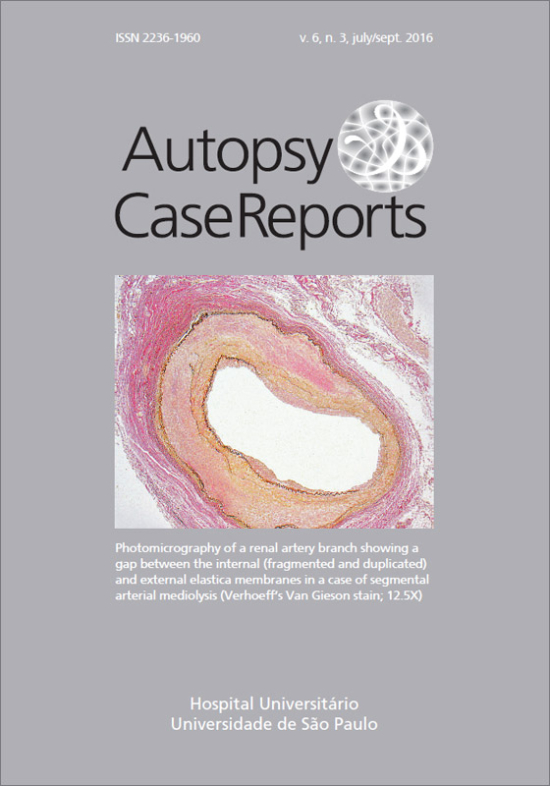Fatal hemoperitoneum due to segmental arterial mediolysis
DOI:
https://doi.org/10.4322/acr.2016.049Keywords:
Splanchnic Circulation, Aneurysm, Abdominal Pain, Fibromuscular dysplasia, AutopsyAbstract
Spontaneous hemoperitoneum due to vascular injury is a life-threatening condition mostly associated with aortic or splanchnic arterial disease, which stems from atherosclerotic, inflammatory, or infectious origin. However, in 1976, Slavin and Gonzales described a nonatherosclerotic arterial disease that may render aneurysmal formation predominantly in the splanchnic arterial bed. The clinical presentation is diverse, but abdominal pain and shock prevail. We report the case of a middle-aged man who presented a hemoperitoneum due to a middle colic artery aneurysm rupture and died after undergoing a surgical treatment attempt. The preoperative imaging study revealed the presence of a huge hematoma in the epiplon retrocavity, and abdominal free liquid as well as extensive arterial disease with multiple aneurysms. The autopsy findings included hemoperitoneum, hematoma in the upper left abdominal quadrant, the surgical ligature of the middle colic artery, and histologic features consistent with segmental arterial mediolysis. The authors call attention to this rare entity and highlight the autopsy as a fundamental examination to accurately reach this diagnosisDownloads
Download data is not yet available.
Published
2016-09-11
Issue
Section
Article / Autopsy Case Report
License
Copyright
Authors of articles published by Autopsy and Case Report retain the copyright of their work without restrictions, licensing it under the Creative Commons Attribution License - CC-BY, which allows articles to be re-used and re-distributed without restriction, as long as the original work is correctly cited.
How to Cite
Felipe-Silva, A., Campos, F. P. F. de, & Martinês, J. A. dos S. (2016). Fatal hemoperitoneum due to segmental arterial mediolysis. Autopsy and Case Reports, 6(3), 7-15. https://doi.org/10.4322/acr.2016.049



